
Dog Separation Anxiety: When Your Dog Can’t Live Without You
Is your dog suffering from separation anxiety?
Like many people, I adopted a new puppy during lockdown. Tulip joined our family as a “foster fail” and now we can’t imagine life without her! In fact, she’s such an integral part of our family, it’s rare that she’s ever left alone.
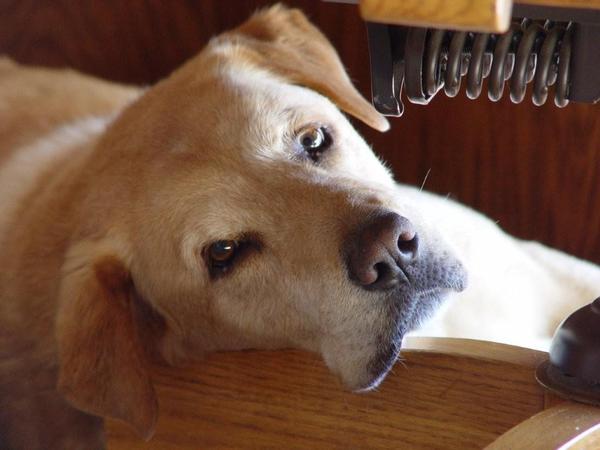
I work from home and, of course, during lockdown, travel has been pretty limited. So Tulip doesn’t know life apart from us. And like many pet parents, it’s concerning to think how she’ll react when life gets back to normal. Not surprisingly, she’s already showing mild signs of separation anxiety.
We’re no strangers to canine anxiety. My heart dog, Buck, had severe separation anxiety, and my dog Chilly, shows severe signs of anxiety because of his noise aversion.
Since an estimated 14% to 17% of dogs are affected by separation anxiety, it’s important to understand why dogs get separation anxiety, what the signs are, and how to get help.1,2
Why Do Dogs Get Separation Anxiety?
It can be all too easy to blame yourself for your dog’s separation anxiety. But believe it or not, the good news is you likely contribute little to the cause of your dog’s separation anxiety.
Dr. Lisa Radosta, DVM, DACVB of Florida Veterinary Behavior Service in West Palm Beach, Florida, reassures pet parents, “It’s not about you.”
Rather, there are a number of reasons why your dog may have developed separation anxiety.
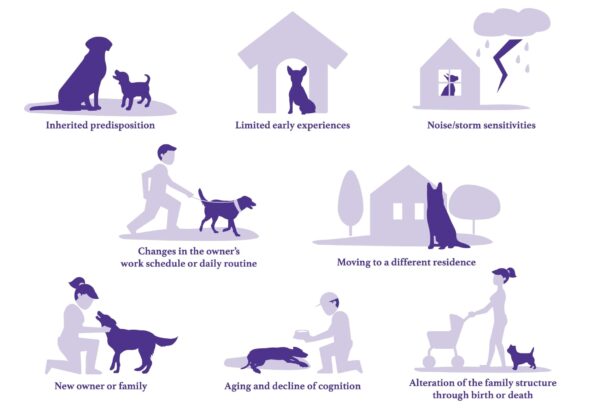
DNA
Dr. Radosta goes on to explain the number one reason for your dog’s separation anxiety is DNA. Some dogs are genetically more prone to separation anxiety than others. They can’t help it any more than you can affect the color of your eyes or how tall you are. It’s simply in their genes.
Traumatic Life Events
Just like humans, when dogs go through traumatic events, it can greatly impact their mental and physical health on a long-term basis.
Dr. Radosta cites rehoming and shelter life as potentially traumatic events. She continues, “Dogs attach to us. And that’s really traumatic for them to be separated suddenly from an attachment figure.”
Pin Me!
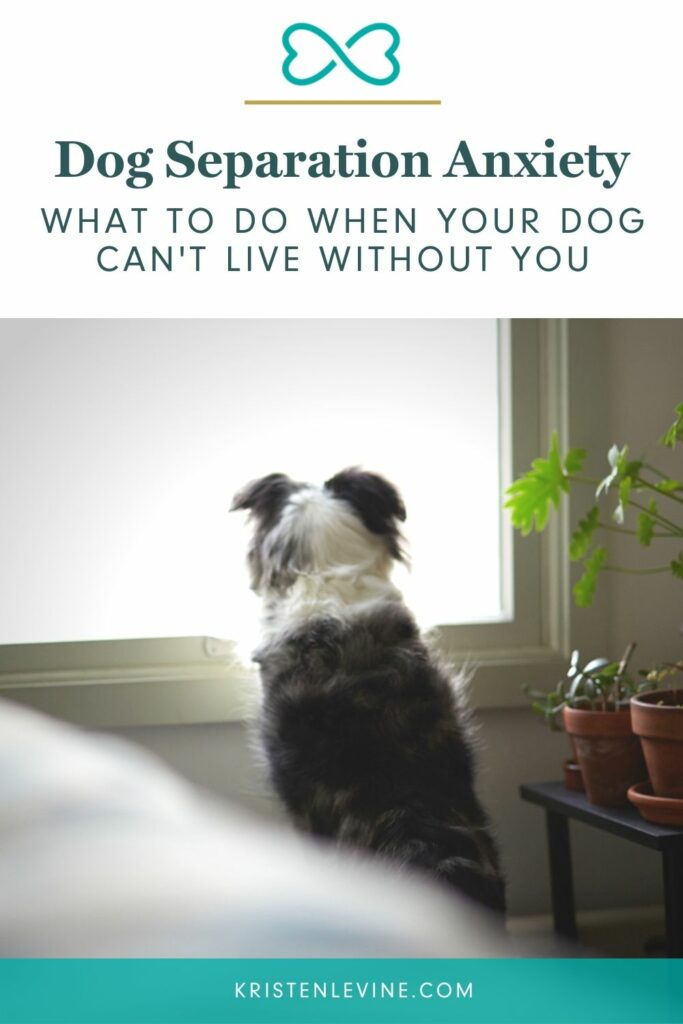
Buck was a shelter dog and we bonded immediately upon his adoption. Early on, he began showing mild signs of separation anxiety that slowly intensified over time, something that is quite common for shelter dogs.
At first, he would try to squeeze out the door to go with me. But over the years, that behavior evolved into him becoming depressed when he knew I was leaving, and eventually, by the time he was 10 years old, he would become terrified when my husband or I left home, to the point where he would cause significant property damage, especially to the door we’d depart from.
Other traumatic events include moving, a change in routine (like going back to work after lockdown), or losing a member of the family.
Limited Experiences, Especially During Puppyhood

This happens to be the case with Tulip. Since she was born and adopted during lockdown, she didn’t have the same early exposure to new places, people, and experiences as my older dog, Chilly.
Rachel Casey, Director of Canine Behaviour and Research at The Dogs Trust, a charity institution, quoted in Yahoo news, says, “A return to normal could be confusing for our dogs, especially puppies acquired during the pandemic who won’t have had these early life experiences.”
However, even older dogs may regress. Casey continues, “It’s safe to say life has not been normal for many of our dogs for the majority of the past year. They’ve had less interactions with other dogs, fewer visitors coming into the home and they haven’t spent much time alone since the pandemic began.”
Noise Aversion/Noise Phobia
As I mentioned earlier, my senior dog, Chilly, has noise aversion. For dogs like him, loud or sudden noises cause signs of panic and anxiety. This condition can contribute to the severity of separation anxiety, especially if loud noises occur when they’re home alone.
Aging and Decline in Cognition
Lastly, your dog’s separation anxiety may be caused by the aging process. Cognitive Dysfunction Syndrome (CDS) and its symptoms appear in about 23% of dogs between the ages of 12 and 14 and 41% of dogs 14 and older.
Despite the many causes of separation anxiety in dogs, Dr. Radosta assures us, “You are not the cause of the problem, but you are the solution.” Yes, there is much we as pet parents can do to alleviate the signs of separation anxiety in our beloved canine companions.
But first, how can you tell if your dog might have separation anxiety?
Signs Your Dog May Have Separation Anxiety
Your veterinarian is best qualified to determine if your dog has separation anxiety. Dr. Patrick Melese, DVM, MA, DACVB, cautions, “There may be underlying medical reasons for a dog exhibiting some of the signs that overlap with separation anxiety (e.g. drooling, urinating & defecating in the house, distress barking/whining, clingy behavior, etc.), which should be ruled out by your primary veterinarian.”
However, there are some signs of separation anxiety you can watch for which will help you start a dialogue with your dog’s doctor.
Dr. Radosta explains some early warning signs may include:
-
- Following you to the door
- Looking depressed as you start to get ready
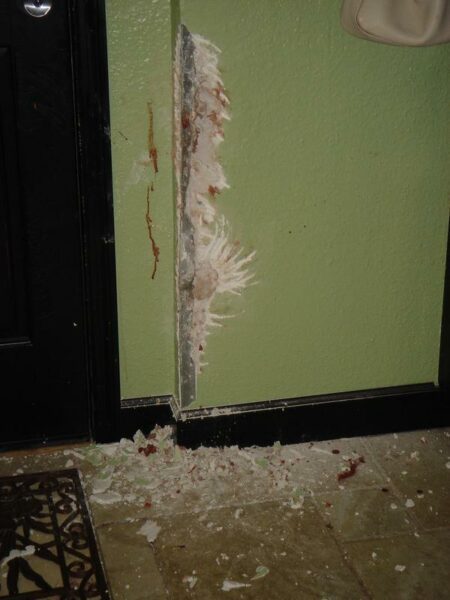
Tulip has begun exhibiting these early signs, which has signaled to us that we need to work on some behavior modification.
As a dog’s separation anxiety progresses, the signs become more intense and may become the equivalent to what a human experiences as a panic attack.
In fact, Dr. Radosta explains, “There is a release of neurochemicals in the brain that affects neurochemicals in the rest of the body and hormones. It’s a big cascade of events during a panic attack. Once your dog mounts that stress response… the body is physiologically activated and that can’t be endured on a chronic basis and have the pet continue to be healthy.”
So what you may perceive as “bad dog behavior,” like property destruction or peeing inside, is actually reflective of a panic attack that affects your dog’s overall health and wellbeing.
My dog Buck, mentioned earlier, would get such severe attacks that he would mangle doorknobs and chew drywall down to the studs! Poor Buck’s teeth became so worn that we couldn’t even feed him dry food anymore.
During these situations, Buck was literally panicking for his life and trying to escape a situation (being alone) that he perceived as dangerous.
However, destructive behavior isn’t the only sign to watch out for.
What are some strong indications that your dog may be suffering from separation anxiety?
-
- Heavy drooling, vomiting, hyperventilating or tachycardia (fast heart rate)
- Destruction of household items by chewing or tearing
- Barking, howling and/or whining
- Defecating or urinating in the house while alone, particularly in “odd” places
- Pacing or circling
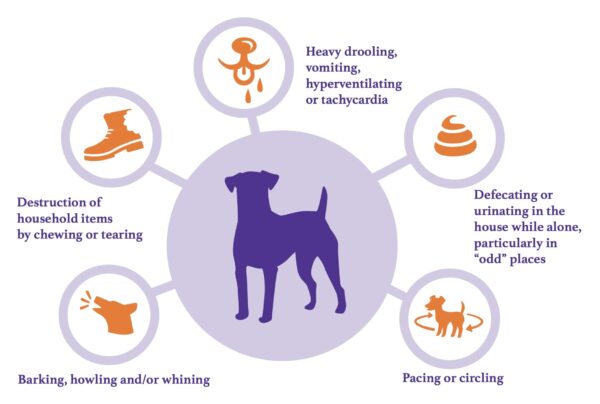
While many dogs may exhibit these behaviors from time to time, dogs with separation anxiety typically engage in these negative behaviors within 10 to 30 minutes of the pet parent’s departure and have bouts of rest alternating with barking and destructive behavior every 40 to 60 minutes. 3, 4, 5
To discover if your dog might be suffering from separation anxiety, take this short quiz and be sure to follow up with your veterinarian.
Sadly, behaviors caused by separation anxiety often result in pet parents choosing to relinquish their dog or, in extreme cases, even to euthanize them.
Clearly, it’s important to treat your dog’s separation anxiety!

How to Treat Dog Separation Anxiety with Behavioral Therapy
Once you’ve ruled out medical reasons for your dog’s separation anxiety, you can proceed to help your dog alleviate his anxiety through behavioral modification.
It’s likely you’ll need the help of a Board Certified Veterinary Behaviorist. These veterinarians specialize in treating behavioral issues in pets and their training in the field of animal behavior is more extensive than a typical veterinarian receives. Think of them as a canine psychiatrist. You can find one in your area by clicking here.
However, if your dog is displaying early or mild signs of separation anxiety, you can try a few at-home behavioral modifications. When combined with medication for separation anxiety, such as Reconcile® (fluoxetine hydrochloride), the BOND™ training program produces measurable improvement in as many as 73% of dogs.
We’ll talk more about Reconcile in a moment, but for now, let’s dive paw-first into at-home behavioral therapies that will need to be used in conjunction with the medication.
Be Positive
Focus on positive behaviors and don’t reprimand for past behaviors. Remember, your dog’s destruction, urination, etc. are not because he’s a bad dog. Rather, they’re a result of panic and distress. Imagine if someone yelled at you during a panic attack!
Only Reward Calm Behavior
Ignore attention-seeking behavior when your dog is overly excited. Rather, look for opportunities to spend calm, quiet time together.
Dr. Radosta recommends “mat work,” spending time together playing or hanging out at a designated spot for your dog, such as a mat.
No More Drama
Your departure should be “no big deal” to your dog, according to Dr. Radosta. How do you teach your dog that your leaving is actually the start of his fun time?
You can start by having short training sessions where you grab your keys or coat, signaling to your dog that you’re about to leave. However, you’ll simply return to your previous activity.
Eventually, your dog should become used to these signals that may have previously set him on the path to anxiety.
You’ll also want to let your dog know that when you leave, it’s his fun time! This is time for him to hang out, have snacks, and do his dog thing.
If you notice your dog’s behavior changes when you grab your travel mug or even perhaps when you start to curl your hair or put on your shoes, that’s the time to give him a nice treat or a toy, preferably one that will occupy him for several minutes.
The idea is to provide positive associations with your leaving.
Develop Your Dog’s Independence
Nothing can make you feel more loved and important than a dog who follows your every step. However, Dr. Radosta advises, “When a dog follows you everywhere, that’s pathologic. It’s not love.”
Give your dog a treat or a toy on a mat and then go about your business around the house. If your dog gets up and follows you, don’t reward him with attention. You want to reinforce the idea this mat is his “safe space,” whether you’re around or not.
I’ve been using the above methods with our puppy, Tulip, and she’s responding beautifully! We’re already seeing a decrease in her signs of separation anxiety.
In conjunction with the BOND™ training program, you can also use drug-free therapies, such as Calmer Canine®. This device works by delivering targeted, pulsed electromagnetic field (tPEMF) signals to the area of the brain responsible for causing the symptoms of anxiety.
The makers of this system recommend two, fifteen-minute sessions daily for four to six weeks to see significant improvement in your dog’s separation anxiety signs.
While behavioral training and modification go a long way to improving your dog’s signs of separation anxiety, the most successful treatment often involves medication.
Medication for Dogs with Separation Anxiety
Despite our best efforts to use behavioral modification with my dog, Buck, his separation anxiety persisted. Our veterinarian prescribed fluoxetine hydrochloride, which was later formulated as a chewable tablet for dogs, now Reconcile® (fluoxetine hydrochloride), and we finally started seeing results!

Reconcile is an FDA-approved chewable tablet approved for the treatment of separation anxiety in dogs in conjunction with behavior modification. It works by blocking the reuptake of serotonin and temporarily increasing the level of this important neurotransmitter in the synapse.
Your dog then has a calmer frame of mind and is more receptive to behavior modification techniques, such as the BOND™ training program.
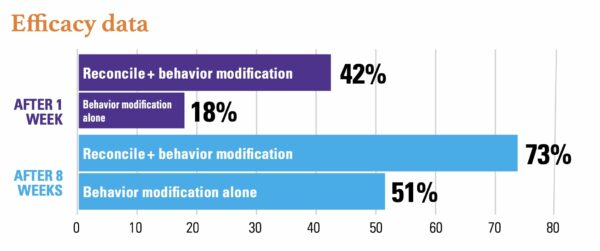
During a recent conversation with Dr. Melese, he stated that “adding an appropriate medication such as Reconcile allows pet owners to move more quickly and with substantially less distress to pet and pet parents while they work to ‘reprogram’ their pet’s response to be left home alone.”
He continued, “Without using medications, behavior modification is quite difficult for working pet parents that cannot avoid having the dog home alone until they have made sufficient progress to leave the pet home alone while they are away for a regular workday.” He added that it can take up to eight weeks of consistent training to see progress with behavior modification alone.
Adding a medication, like Reconcile, designed to target the signs of separation anxiety along with behavioral training can significantly improve results, and in turn, your dog’s state of mind and well-being.
But is it safe to give your dog Reconcile on a long-term basis?
Reconcile is approved for use for up to eight weeks. When prescribed and used as directed, Reconcile is proven safe.
Since only your veterinarian can prescribe Reconcile, your dog’s response to the medication is monitored through regular visits and any adverse side effects can be managed by your veterinarian.
Reconcile is contraindicated in some cases, so it’s very important to thoroughly review your dog’s medical history with your veterinarian.
For my dog, Buck, medication was a game changer! Previously, when Buck’s condition was at its worst, my husband and I could never leave him alone. We even went so far as to take separate vacations!
But with fluoxetine hydrochloride (Reconcile®) and behavior modification, for the first time ever, Buck’s separation anxiety became manageable and we could finally leave the house knowing he wouldn’t be miserable during our absence.
So does that mean your dog can be cured of separation anxiety?
Is Your Dog’s Separation Anxiety Curable?
In short, the answer is no. However, Dr. Radosta states that separation anxiety is “treatable to the point where it’s almost invisible.”
She emphasizes that ongoing behavioral training and consistent and proper use of medication can make the signs of separation anxiety nearly imperceptible.
If your dog is suffering from signs of separation anxiety, be sure to visit your veterinarian as soon as possible. We owe it to our dogs to be the custodians of their health and well-being, both mental and physical.

IMPORTANT SAFETY INFORMATION: The most common adverse events in decreasing order of reported frequency are: decreased appetite, depression/lethargy, shaking/shivering/tremor, vomiting, restlessness and anxiety, seizures, aggression, diarrhea, mydriasis, vocalization, weight loss, panting, confusion, incoordination, and hypersalivation. Reconcile chewable tablets are contraindicated for dogs with a history of seizures or when used with MAOIs. Reconcile® chewable tablets are indicated for the treatment of canine separation anxiety in conjunction with a behavior modification plan. Federal law restricts this drug to use by or on the order of a licensed veterinarian. Consult your veterinarian for complete safety information or click here to read the package insert.
Kristen Levine has a consulting relationship with PRN® Pharmacal.
-
- Bamberger M, Houpt KA. Signalment factors, comorbidity, and trends in behavior diagnoses in dogs: 1,644 cases (1991-2001). JAVMA. 2006;229(10):1593.
- Tiira K, Sulkama S, Lohi H. Prevalence, comorbidity, and behavioral variation in canine anxiety. J Vet Behav. 2016;16:38.
- Parthasarathy V, Crowell-Davis SL. Relationship between attachment to owners and separation anxiety in pet dogs (Canis lupus familiaris). J Vet Behav. 2006;1:109-120.
- Blackwell E, Casey RA, Bradshaw WS. Controlled trial of behavioural therapy for separation-related disorders in dogs. Vet Rec. 2006;158:51-554.
- Horwitz DF. Separation anxiety in dogs. NAVC Clinician’s Brief. 2008;11:61-62.







Comments (0)